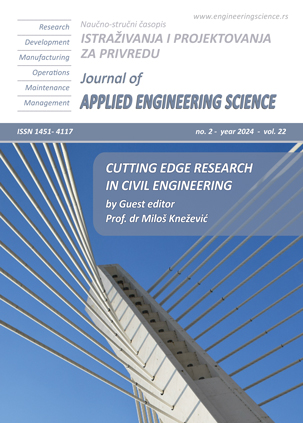ENERGY EFFICIENCY OF A HYBRID ROAD TRAIN WITH AN ACTIVE SEMI-TRAILER FOR ROAD CONSTRUCTION WORK
Abstract
The previous experience of creating experimental road trains with an active trailer and semi-trailer is analyzed against the background of modern technological capabilities of transport engineering and the logistical needs of modern construction. The expediency of implementing the concept of a road train with an active trailer based on modern electromechanical technologies is shown. The purpose of the study is to increase the energy efficiency of road trains used in construction for transporting long-length objects (beams, piles, bridge trusses, panels, etc.) by using an active trailer link with an electromechanical drive. The study solves the problem of modeling the movement of road trains with passive and active semi-trailers and comparing their energy efficiency and safety indicators. The methods of modeling the movement of cars and road trains, characteristic of the theory of movement of transport vehicles, approaches of theoretical mechanics and applications of differential calculus, applied numerical modeling in the SimuLink environment are used. A mathematical model has been obtained that allows calculating the energy efficiency of a road train when using passive (towed) and active semi-trailers. The cycle of the road train movement has been developed and tested for use in severe road conditions (construction with weak road infrastructure, forest complex, transportation of special cargo). The implementation of the computational model by means of the SimuLink software package is proposed. Based on the simulation results, conclusions are made on the energy efficiency and safety of road trains with an active trailer link with an electromechanical transmission.
References
Zapryagaev, M. M. [et al]. (1970). Army vehicles. Construction and calculation. Part two. Voenizdat, 480 p,
Kochnev E. D. (2011). Secret cars of the Soviet Army. Eksmo, Moscow: Yauza.
Dobretsov, R., Gubachev, M., Naletov, I. and Vasiliev, A. (2018). On the way to a driverless road train: Digital technologies in motion modeling, calculation and design of a road train with a hybrid power plant. IV International Scientific Conference "Convergence of Digital and Physical Worlds: Technological, Economic and Social Challenges" (CC-TESC2018), pp. 1-9
Vasiliev, A., Dobretsov, R. (2022). Energy Consumption of a Hybrid Road Train with a Generator Set. In: Evgrafov, A.N. (eds) Advances in Mechanical Engineering. Lecture Notes in Mechanical Engineering. Springer, Cham., https://doi.org/10.1007/978-3-030-91553-7_21
Ankinovich, G. G., Gorelov, V. A., Chudakov, O. I. (2017). Evaluation of the effect of activation of semi-trailer wheels on traction-dynamic properties of a road train. Izvestiya vuzov. Mechanical engineering, Vol. 1, No 682, URL:https://cyberleninka.ru/article/n/otsenka-vliyaniya-aktivizatsii-koles-polupritsepa-na-tyagovo-dinamicheskie-svoystva-avtopoezda (accessed: 07/14/2023).
Vasiliev, A. I., Gubachev, M. S., Dobretsov, R. Yu. (2018). Estimation of the power of resistance to movement of a trailer of a logging train. Improving the efficiency of the forest complex. Materials of the fourth All-Russian Scientific and Practical conference with international participation, pp. 32-33,
Dobretsov, R. Yu. [et al]. (2016). The choice of a schematic version of the construction of transmissions of military vehicles with a hybrid power plant. Collection of articles of the scientific and practical conference "Development and use of electric transmissions for samples of weapons and military equipment (JSC "VNIITransmash"), The publication of JSC "VNIITransmash", Saint Petersburg, pp. 87-100.
Shegelman, I. R., Skrypnik, V. I., Vasiliev A. S. (2011). Justification of technical solutions for the creation of a high-passable logging road train. TDR, No. 7, pp. 64-66, URL: https://cyberleninka.ru/article/n/obosnovanie-tehnicheskih-resheniy-po-sozdaniyu-vysokoprohodimogo-lesovoznogo-avtopoezda (accessed: 07/14/2023).
Ranjit, P. S., Reddy, M. S., Bhurat, S. S. [et al.]. (2022). Experimental studies of the Pinus Sylvestris oil–based diesel engine with the addition of hydrogen to increase productivity and reduce emissions. FME Transactions, Vol. 50, No. 2, pp. 313-321. DOI 10.5937/fme2201313R.
Shepelev, V., Gritsenko, A., Salimonenko, G. (2021). Control of hydrocarbon emissions when changing the technical condition of the exhaust system of modern cars. FME Transactions, Vol. 49, No. 3, pp. 749-755.DOI 10.5937/fme2103749S.
Gorelov V. A., Padalkin B. V., Chudakov O. I. (2016). Development of an algorithm for power distribution in the transmission of an active saddle road train based on the analysis of power factors in the coupling device, Science and Education. Bauman Moscow State Technical University. Electron. Journal, No. 12, pp. 1-17.
Gorelov V. A., Padalkin B. V., Chudakov O. I. (2017). Mathematical model of rectilinear motion on a deformable support surface of a two-link saddle road train with an active semi-trailer link. Bulletin of the Bauman Moscow State Technical University. Ser. Mechanical Engineering, Vol. 2, No. 113, pp. 121-136. DOI: 10.18698/0236-3941-2017-2-121-138
Dubovik D. A. (2010). The hypothesis of the linear distribution law of the support reactions of wheels of multi-axle wheeled vehicles and the methodology of its experimental substantiation. Bulletin of the Belarusian-Russian University, No. 2, pp. 28-33. URL: https://cyberleninka.ru/article/n/gipoteza-lineynogo-zakona-raspredeleniya-opornyh-reaktsiy-koles-mnogoosnyh-kolesnyh-mashin-i-metodika-ee-eksperimentalnogo (accessed: 07/14/2023).
Chudakov O. I. (2017). Dissertation for the degree of Candidate of Technical Sciences "Development of the law of power distribution between links in the rectilinear movement of a road train based on the analysis of force factors in the coupling device". Moscow, 145 p.
Tarasik, V. P. (2006). Theory of car movement: textbook for universities. BHV-Petersburg, St. Petersburg.
Radjic, D. S. (2021). A mathematical and physical model for solving inventive problems. FME Transactions, Vol. 49, No. 3, pp. 726-733 DOI 10.5937/fme2103726R.
Didikov, R. A. [et al]. (2017). Power distribution control in the transmission of a promising wheeled tractor. Procedia Engineering, Vol. 206, pp. 1735-1740.

